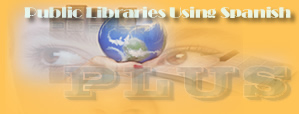|
Back
to The
Reference Shelf
Library
Service to Spanish-Speaking Patrons: A Practical Guide
by Sharon Chickering Moller. Englewood,
CO: Libraries Unlimited. 2001. ISBN 1-56308-719-7. 207pp.
index; bibliography $28.00
Orders:
1-800-237-6124
www.lu.com
A concise, tip-filled
volume aimed at public librarians and educators. Although Chickering
Moller works in an academic library, she serves the general public
as well; this and her cooperation over the years with colleagues
serves as the basis of the know-how presented in this valuable
guide. This is sure to be an indispensable resource for librarians
who have little knowledge of Spanish, but Chickering Moller has
packed the book with so many case studies and practical ideas
that LSSP (the book, not the notorious--oh,
never mind...) is sure to be of use even to those with substantial
experience. Her perspective as a small-town college librarian
in semi-rural Colorado gives the author a familiarity with the
issues faced by librarians in small, changing communities all
over the U.S.
Chickering Moller has lived in and visited a number
Spanish-speaking countries. She touches on her own struggles with
the language, and serves up her personal impressions of libraries
and school systems in several parts of Latin America: Mexico,
Chile, Ecuador, and Puerto Rico.
The author has assembled some truly impressive
resource lists. Selection tools, organizations, and awards are
covered here fairly comprehensively. Compilations of Internet-based
resources reflect a good deal of effort; it's a pity that the
publisher doesn't wake up and offer these rosters in an online
format, because many of URLs were of course already obsolete by
the time the book was published.
An appendix devoted to library vocabulary, phrases,
and translations of forms is reliable and--exceptional for such
books--nearly error-free.
Other strengths include 25 reviews of Spanish-language
and bilingual magazines complete with distributor information,
and numerous examples of outstanding programming work including
names of the libraries and service providers involved. Entire
chapters devoted to YA and childrens' services reflect the author's
apparent longstanding engagement with these elements of library
service; she even gives some space to consideration of childhood
language use patterns. Chickering Moller truly shines in her discussions
of preschool and early childhood education issues and cognitive
factors. Her in-depth and thoughtfully documented approach to
nearly all her topics, in fact, would make this a good textbook
for LIS courses on pluricultural services.
A wealth of pointers drawn from wide-ranging expert
interviews and trial-and-error experience enhance the book's practicality.
An example: "When possible, hand the future patron a temporary
library card on the spot. My experience has been that [it] may
act as an admission ticket--one less hurdle to overcome."
Chickering Moller advises patience and sensitivity; when communication
breaks down with non-English-speaking patrons, "the staff
should apologize and make it his or her fault" for not understanding,
rather than the other way around.
This is a terrific complement to Alire and Archibeque's
Serving Latino
Communities: A How-To-Do-It Manual for Librarians.
In fact, if you're faced with a choice between the two, this newer
volume is probably the one to get.
|



